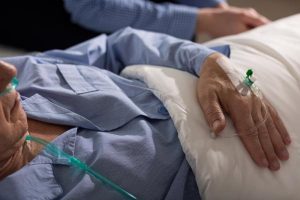- Home
- Editorial
- News
- Practice Guidelines
- Anesthesiology Guidelines
- Cancer Guidelines
- Cardiac Sciences Guidelines
- Critical Care Guidelines
- Dentistry Guidelines
- Dermatology Guidelines
- Diabetes and Endo Guidelines
- Diagnostics Guidelines
- ENT Guidelines
- Featured Practice Guidelines
- Gastroenterology Guidelines
- Geriatrics Guidelines
- Medicine Guidelines
- Nephrology Guidelines
- Neurosciences Guidelines
- Obs and Gynae Guidelines
- Ophthalmology Guidelines
- Orthopaedics Guidelines
- Paediatrics Guidelines
- Psychiatry Guidelines
- Pulmonology Guidelines
- Radiology Guidelines
- Surgery Guidelines
- Urology Guidelines
Sepsis survivors with higher inflammation after discharge at higher risk for death: JAMA

USA: More than 60% of the patients who survived hospitalization for sepsis had a persistent elevation of inflammation and immunosuppression biomarkers a year after discharge, increasing the risk for major health problems and death.
Findings of the study, published in the journal JAMA suggest that long-term immunomodulation strategies should be explored in patients hospitalized with sepsis that would provide an insight into future treatments that may improve outcomes for sepsis survivors.
Sepsis, that affects an estimated 20 million people per year with a mortality rate of up to 50%, is a life-threatening condition. It occurs when an existing infection — such as one that develops in a cut, a respiratory infection, or a urinary tract infection — triggers an immune response that affects the body’s tissues and major organs. Sepsis constitutes a medical emergency because, if a person does not receive treatment, it can lead to death. Most commonly, the condition is caused by Staphylococcus aureus and Escherichia coli.
Sachin Yende, Veterans Affairs Pittsburgh Healthcare System, Pittsburgh, Pennsylvania, and colleagues assessed whether abnormalities in the host immune response during hospitalization for sepsis persist after discharge.
“Our new findings of chronic inflammation post-discharge suggest that addressing this condition may be important to improve patients’ long-term outcomes," said Yende.
For the study, the researchers followed 483 people (mean [SD] age, 60.5 [15.2] years; 265 [54.9%] male) who were hospitalized with sepsis at one of the 12 U.S. hospitals between 2012 and 2017 and survived to be discharged. Detailed information of the participants were gathered through telephone, home visits at an interval of 3, 6 and 12 months after enrollment for health interviews and a blood sample.
Also Read: One-third of patients of severe sepsis at risk of Heart attack,Stroke
Key findings include:
- A total of 376 patients (77.8%) had at least 1 chronic disease, and their mean (SD) Sequential Organ Failure Assessment score was 4.2 (3.0).
- Readmissions were common (485 readmissions in 205 patients [42.5%]), and 43 patients (8.9%) died by 3 months, 56 patients (11.6%) died by 6 months, and 85 patients (17.6%) died by 12 months.
- Elevated hs-CRP levels were observed in 23 patients (25.8%) at 3 months, 26 patients (30.2%) at 6 months, and 23 patients (25.6%) at 12 months, and elevated sPD-L1 levels were observed in 45 patients (46.4%) at 3 months, 40 patients (44.9%) at 6 months, and 44 patients (49.4%) at 12 months.
- Two common phenotypes were identified based on hs-CRP and sPDL1 trajectories: high hs-CRP and sPDL1 levels (hyper inflammation and immunosuppression phenotype [326 of 477 (68.3%)]) and normal hs-CRP and sPDL1 levels (normal phenotype [143 of 477 (30.0%)]).
- These phenotypes had similar clinical characteristics and clinical course during hospitalization for sepsis.
- Compared with normal phenotype, those with the hyper inflammation and immunosuppression phenotype had higher 1-year mortality, 6-month all-cause readmission or mortality, and 6-month readmission or mortality attributable to cardiovascular disease or cancer.
- These associations were adjusted for demographic characteristics, chronic diseases, illness severity, organ support, and infection site during sepsis hospitalization and were robust in sensitivity analyses.
Also Read: Prophylactic antibiotics after assisted childbirth decrease Sepsis risk: Lancet
The researchers cautioned that they did not have blood tests on the study participants before their sepsis diagnosis. It is possible that they had elevated levels prior to hospitalization that may have contributed to the development of sepsis and continued to persist after hospitalization.
"The dysregulated host immune response activated during sepsis may persist up to 1 year. Individuals with persistent biomarkers of inflammation and immunosuppression had a higher risk of readmission and death due to cardiovascular disease and cancer compared with those with normal circulating biomarkers," concluded the authors.
To read the complete study follow the link: doi:10.1001/jamanetworkopen.2019.8686

Disclaimer: This site is primarily intended for healthcare professionals. Any content/information on this website does not replace the advice of medical and/or health professionals and should not be construed as medical/diagnostic advice/endorsement or prescription. Use of this site is subject to our terms of use, privacy policy, advertisement policy. © 2020 Minerva Medical Treatment Pvt Ltd